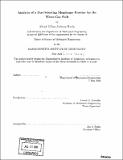| dc.contributor.advisor | Ernest G. Cravalho. | en_US |
| dc.contributor.author | Hardy, AliciA Jillian Jackson, 1978- | en_US |
| dc.contributor.other | Massachusetts Institute of Technology. Dept. of Mechanical Engineering. | en_US |
| dc.date.accessioned | 2005-09-06T21:33:23Z | |
| dc.date.available | 2005-09-06T21:33:23Z | |
| dc.date.issued | 2004 | en_US |
| dc.identifier.uri | http://hdl.handle.net/1721.1/27063 | |
| dc.description | Thesis (S.M.)--Massachusetts Institute of Technology, Dept. of Mechanical Engineering, June 2004. | en_US |
| dc.description | "May 2004." | en_US |
| dc.description | Includes bibliographical references (p. 69-71). | en_US |
| dc.description.abstract | The water-gas shift reaction is an exothermic and reversible catalytic process that converts carbon monoxide and water (steam) to hydrogen and carbon dioxide. In regard to energy-related issues, the water-gas shift is part of the process of reforming hydrocarbons to produce hydrogen suitable for fuel cells; carbon monoxide poisons the low temperature fuel cells (phosphoric acid and polymer electrolyte membrane fuel cells) and must therefore be removed. The reaction is limited by thermodynamic equilibrium at higher temperatures, while kinetics are unfavorable at the lower temperatures. Current commercial technology uses at least two adiabatic beds with cooling between the beds to address this issue. The first bed is a high temperature shift in which reaction rates are high, and the second is a low temperature shift where final equilibrium conversions are high. The high temperature shift is made less unfavorable thermodynamically by reacting the gas with an excess of steam. Membrane reactors are expected to eliminate the thermodynamics/kinetics trade-off by separating either the hydrogen or the carbon dioxide while the forward reaction is in progress. In such a reactor, excess steam might not be required; commercial catalysts are not well studied under conditions in which the pressure is high and the feed is near stoichiometric, as they would be in membrane reactor. Further study of old and new catalysts under these conditions is necessary step toward making membrane reactors marketable. There is a whole body of literature regarding new catalysts for the water-gas shift, and there are certainly other methods to produce hydrogen besides steam reforming natural gas. However, in order to be marketable now, fuel cells need to use | en_US |
| dc.description.abstract | (cont.) primary fuel sources from existing production and distribution networks (such as natural gas, gasoline, diesel fuel and jet fuel), and the exhaustive body of knowledge that has been gathered over the past century regarding today's common water-gas shift catalysts suggests that there are under-investigated design options to pursue. In this vain, the current work studies how to more efficiently use the most common and best understood high temperature water-gas shift catalyst: ferrochrome Fe₃0₄ with a Cr₂0₃ promoter. The current work suggests the application of this catalyst in a membrane reactor environment in which the partial pressures of both hydrogen and carbon dioxide are both low. | en_US |
| dc.description.statementofresponsibility | by AliciA Jillian Jackson Hardy. | en_US |
| dc.format.extent | 96 p. | en_US |
| dc.format.extent | 3244770 bytes | |
| dc.format.extent | 3255705 bytes | |
| dc.format.mimetype | application/pdf | |
| dc.format.mimetype | application/pdf | |
| dc.language.iso | en_US | |
| dc.publisher | Massachusetts Institute of Technology | en_US |
| dc.rights | M.I.T. theses are protected by copyright. They may be viewed from this source for any purpose, but reproduction or distribution in any format is prohibited without written permission. See provided URL for inquiries about permission. | en_US |
| dc.rights.uri | http://dspace.mit.edu/handle/1721.1/7582 | |
| dc.subject | Mechanical Engineering. | en_US |
| dc.title | Analysis of a duo-selecting membrane reactor for the water-gas shift | en_US |
| dc.type | Thesis | en_US |
| dc.description.degree | S.M. | en_US |
| dc.contributor.department | Massachusetts Institute of Technology. Department of Mechanical Engineering | |
| dc.identifier.oclc | 56802924 | en_US |
